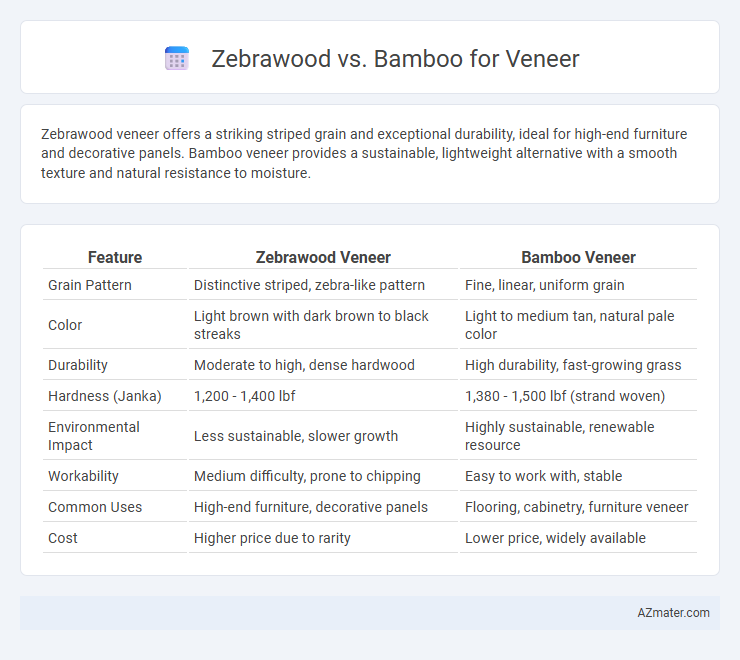Zebrawood veneer offers a striking striped grain and exceptional durability, ideal for high-end furniture and decorative panels. Bamboo veneer provides a sustainable, lightweight alternative with a smooth texture and natural resistance to moisture.
Table of Comparison
| Feature | Zebrawood Veneer | Bamboo Veneer |
|---|---|---|
| Grain Pattern | Distinctive striped, zebra-like pattern | Fine, linear, uniform grain |
| Color | Light brown with dark brown to black streaks | Light to medium tan, natural pale color |
| Durability | Moderate to high, dense hardwood | High durability, fast-growing grass |
| Hardness (Janka) | 1,200 - 1,400 lbf | 1,380 - 1,500 lbf (strand woven) |
| Environmental Impact | Less sustainable, slower growth | Highly sustainable, renewable resource |
| Workability | Medium difficulty, prone to chipping | Easy to work with, stable |
| Common Uses | High-end furniture, decorative panels | Flooring, cabinetry, furniture veneer |
| Cost | Higher price due to rarity | Lower price, widely available |
Introduction to Zebrawood and Bamboo Veneer
Zebrawood veneer, known for its distinctive dark stripes resembling a zebra's pattern, offers a luxurious and exotic look with high durability ideal for furniture and decorative paneling. Bamboo veneer features a sustainable, eco-friendly profile with a smooth texture and light color, favored in modern, minimalist designs for its rapid renewability and strength. Both veneers provide versatile aesthetics, with Zebrawood emphasizing bold visual impact and Bamboo enhancing natural warmth and environmental benefits.
Origin and Sustainability: Zebrawood vs Bamboo
Zebrawood, sourced primarily from West African countries like Gabon and Cameroon, is prized for its striking striped grain but faces sustainability challenges due to slower growth and overharvesting risks. Bamboo, originating in Asia and rapidly renewable, offers a highly sustainable alternative with fast growth cycles and minimal environmental impact. Choosing bamboo veneer supports eco-friendly practices, while zebrawood veneer provides unique aesthetics often linked with premium, less sustainable hardwoods.
Appearance and Aesthetic Differences
Zebrawood veneer showcases striking, contrasting dark brown and light tan stripes, creating a bold, exotic look with a high-gloss finish that emphasizes its natural grain pattern. Bamboo veneer features a consistent, fine-grained texture with light golden hues and subtle nodes, offering a clean, modern, and eco-friendly aesthetic. The rich, dramatic character of Zebrawood complements luxury and statement pieces, while Bamboo provides a minimalist, warm, and sustainable alternative for contemporary designs.
Strength and Durability Comparison
Zebrawood veneer offers exceptional hardness and resistance to wear, making it ideal for high-traffic surfaces requiring long-term durability. Bamboo veneer, known for its renewable nature, provides excellent tensile strength and flexibility but generally ranks lower in hardness compared to Zebrawood. While Zebrawood excels in dense, heavy-duty applications, bamboo's resilience and environmental benefits suit lighter, eco-friendly projects.
Environmental Impact and Eco-Friendliness
Zebrawood veneer, derived from the highly sought-after microberlinia tree native to West Africa, often raises environmental concerns due to deforestation and slow growth rates, impacting sustainability. Bamboo veneer, made from rapidly renewable grass species with a high carbon absorption rate, offers a more eco-friendly alternative with minimal habitat disruption and quicker regeneration. Choosing bamboo veneer supports lower environmental impact through sustainable harvesting practices and reduced carbon footprint compared to Zebrawood.
Cost and Affordability Analysis
Zebrawood veneer, known for its distinctive striped grain, typically commands a higher price due to limited availability and intricate processing requirements. Bamboo veneer offers a cost-effective alternative, providing durability and eco-friendly benefits at a fraction of Zebrawood's expense. Selecting between Zebrawood and bamboo veneers hinges on balancing budget constraints with desired aesthetic appeal and sustainability considerations.
Ease of Installation and Workability
Zebrawood veneer, known for its distinctive striped grain, offers moderate ease of installation but requires careful handling due to its density and potential for splintering, demanding precise cutting tools and sanding techniques. Bamboo veneer, prized for its uniform texture and flexibility, provides excellent workability with easier cutting, shaping, and gluing, making it ideal for both novice and advanced woodworkers during installation. Both materials benefit from proper adhesive choice and surface preparation, yet bamboo's renewable nature and easier machinability often result in faster, more efficient veneer application.
Maintenance and Longevity
Zebrawood veneer offers high durability and requires minimal maintenance due to its dense grain and natural resistance to wear, making it ideal for long-lasting applications. Bamboo veneer, while eco-friendly and renewable, needs regular sealing and careful cleaning to prevent moisture damage and surface scratches, affecting its longevity over time. Choosing between the two depends on the balance between durability preferences and environmental considerations for maintenance frequency and lifespan.
Common Applications in Interior Design
Zebrawood veneer offers striking, bold grain patterns ideal for statement furniture pieces, paneling, and luxury cabinetry, adding visual drama to interiors. Bamboo veneer, prized for its sustainability and smooth texture, is commonly used in flooring, wall coverings, and modern furniture, promoting eco-friendly and minimalist design aesthetics. Both materials enhance interior design with unique visual appeal and functional durability, catering to diverse stylistic preferences.
Choosing the Right Veneer: Zebrawood or Bamboo?
Zebrawood veneer offers a striking, bold grain pattern with rich, contrasting stripes ideal for statement pieces, while bamboo veneer provides a sustainable, eco-friendly option with a uniform, fine texture and excellent durability. Bamboo's rapid growth and renewability make it a cost-effective choice for environmentally conscious projects, whereas zebrawood's exotic appeal suits luxury interiors seeking distinct visual impact. Selecting between zebrawood and bamboo veneers depends on balancing aesthetic preferences, budget constraints, and sustainability goals for the specific application.

Infographic: Zebrawood vs Bamboo for Veneer
 azmater.com
azmater.com